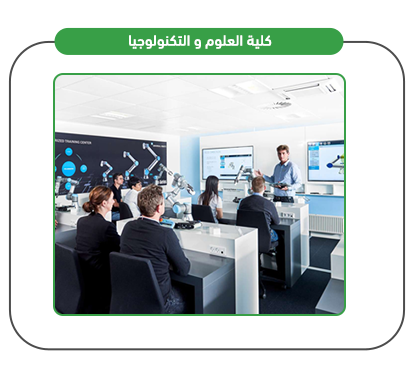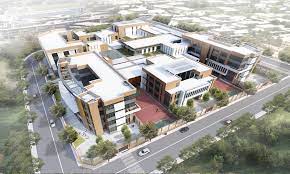The feasibility study for the College of Science and Technology aims to assess the feasibility of establishing a specialized institution that meets the growing demand for scientific and technological competencies. The study includes a comprehensive analysis of the economic, social, and technical factors affecting the project’s success, with a focus on identifying various labor market needs. The study includes an assessment of the necessary infrastructure, such as buildings, laboratories, and equipment, along with an estimation of the costs associated with the establishment and operation process. Criteria for selecting faculty and technicians are also determined to ensure the quality of the educational process, in addition to developing a curriculum development plan in accordance with international academic standards. On the financial side, potential revenues from tuition fees are estimated, along with an analysis of operational costs to ensure the project’s sustainability. The study also includes the development of a comprehensive financing plan and a timeline for the efficient implementation of the project phases. The importance of the feasibility study lies in providing a clear vision of potential strengths and challenges, which helps in making strategic decisions that contribute to the project’s success and ensure the achievement of its educational and development goals.

The College of Science and Technology project is a strategic investment aimed at preparing qualified personnel who keep pace with scientific developments and contribute to supporting sustainable development. The college seeks to create a stimulating environment for research and innovation by offering specialized academic programs that integrate theoretical and applied sciences, ensuring students are equipped with practical skills commensurate with the needs of the labor market. The project’s importance lies in several aspects, most notably the graduation of qualified specialists in fields that witness increasing demand locally and globally, in addition to supporting innovation and entrepreneurship by providing an academic environment that encourages students to develop creative and innovative solutions. The college also contributes to community development by producing research that addresses pressing issues. It also promotes international cooperation by building academic and research partnerships with global institutions, which greatly facilitates the exchange of expertise and raises the level of education and scientific research. Thus, the project is an important step towards building an advanced educational system that supports the transition to a knowledge-based economy and enhances the country’s position in the scientific and technological arena. If you are interested in investing in this successful project, contact your project experts to obtain an unparalleled feasibility study for the College of Science and Technology at a competitive price.



Building a Scientific Community
Diverse academic programs covering multiple disciplines.
Focusing on practical application through laboratories and research projects.
Qualified and experienced faculty.
Encouraging and supporting scientific research.
Close relationships with the industrial sector to provide training opportunities.
A learning environment that stimulates creativity and innovation.
Developing personal skills such as teamwork and critical thinking.
Meeting the needs of the labor market with qualified graduates.
Contributing to solving societal problems through research.
Through conferences and workshops.
Executive summary
Study project services/products
Market Size Analysis
Risk Assessment
Technical study
Financial study
Organizational and administrative study

The Education Sector in the GCC Countries
Believing in the importance of the education sector and its role in promoting the localization of the national workforce, Mashroo3k for Economic Consultancy and Market Research is pleased to present the following key indicators of the education sector in the Gulf Cooperation Council (GCC) countries, inviting investment in this vital field:
The total number of students in Early Childhood Development (including nurseries and kindergartens) across the GCC reached approximately 851,500 students, according to the latest available statistics.
The number of students enrolled in school education stages across the GCC is estimated at around 9.3 million students (79.4% in the public sector and 20.6% in the private sector).
The number of learners in adult education centers is estimated at 181,247 students.
The number of students enrolled in higher education institutions stands at 2,206,446 students.
The number of early childhood teachers is approximately 50,647.
The number of school education teachers is estimated at around 727,904.
There are 5,806 operational early childhood education institutions.
There are 32,310 operational school education institutions.
Over the past years, GCC governments have actively sought to bridge the gap between education and the labor market by adopting educational curricula that emphasize vocational and technical education and encourage learning through modern technologies and digital platforms. It is also worth noting the increasing investment in education quality across the six countries to produce graduates who meet the private sector’s workforce requirements.
According to the latest statistics:
Saudi Arabia allocates 18.9% of its budget to education.
The UAE allocates 14.8% of its budget to education.
Oman allocates 12.2% of its budget to education.
Bahrain allocates 9.8% of its budget to education.
Kuwait allocates 12.3% of its budget to education.
Qatar allocates 10.5% of its budget to education.
By 2023, the value of the private education market in the GCC is expected to reach USD 26.2 billion.
The Global Education Sector
The global education services market was valued at approximately USD 2,882.52 billion by the end of 2021. Experts project that the market will reach USD 3,191.79 billion by the end of 2022, achieving a compound annual growth rate (CAGR) of 10.7%. Furthermore, by 2026, the market value is expected to rise to USD 4,623.90 billion, reflecting a CAGR of 9.7% over the forecast period.

Investment in the Saudi private education sector grew by 3% in 2016, rising to 15.5% compared to 12.5% in 2015. Investment in the private education sector has increased over the past five years, reaching approximately 10 billion riyals.